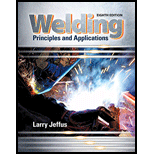
Why are all welds not inspected to the same level or standard?
The reason all welds are not inspected to the same level or standard.
Answer to Problem 1R
The quality of the weld that will pass or be acceptable for one welding application may not meet the needs of another.
Explanation of Solution
Given Information:
All welds are not inspected to same level or standard.
All welds are not inspected to the same level. The required quality of welds depends on the service which the object provides.
A high-quality weld is required in nuclear reactors, while a moderate quality of weld may work for house window.
So, the inspection of welds for nuclear reactor should higher the standards, but same standard for welds of house window will not be needed. Therefore, all the welds are not inspected to the same level or standard, rather it depends on the service of the object.
Want to see more full solutions like this?
Chapter 25 Solutions
Welding: Principles and Applications (MindTap Course List)
 Welding: Principles and Applications (MindTap Cou...Mechanical EngineeringISBN:9781305494695Author:Larry JeffusPublisher:Cengage Learning
Welding: Principles and Applications (MindTap Cou...Mechanical EngineeringISBN:9781305494695Author:Larry JeffusPublisher:Cengage Learning
